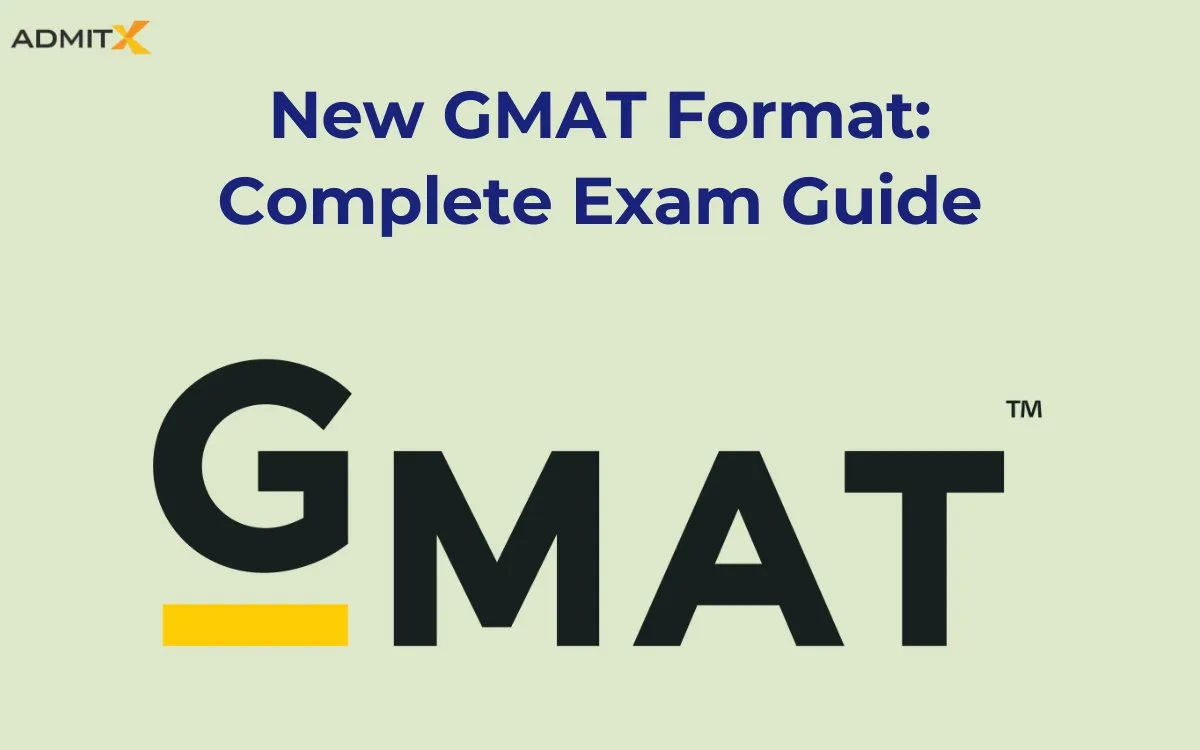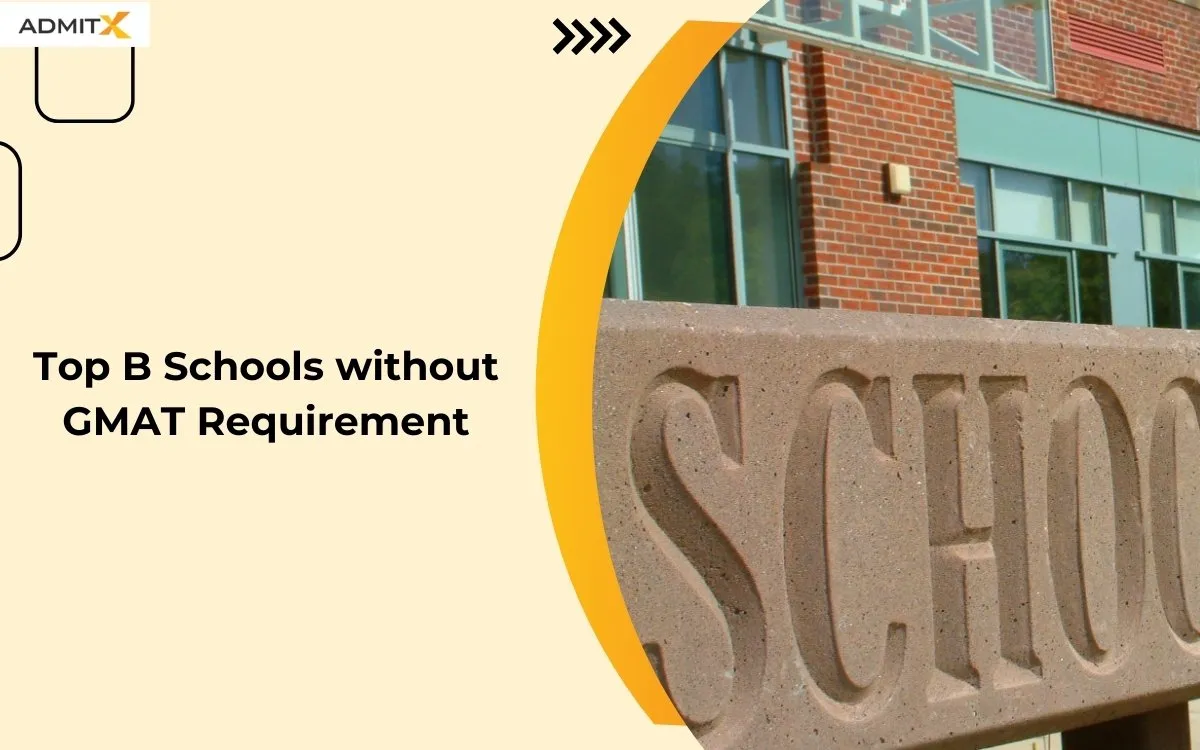
New GMAT Format: Complete Exam Guide
GMAT, or Graduate Management Admission Test, is an exam for candidates wishing to enter business schools for management-related courses. This test evaluates your analytical, writing, quantitative, integrated, and verbal reasoning skills, giving you a score allowing you to be admitted to a rigorous business program. Through this GMAT exam syllabus guide, we will provide you with knowledge and strategies to confidently appear for GMAT and score well.
The new GMAT format provides access to leading business and management schools across the globe. It assesses a candidate’s critical thinking, reasoning, and communication capabilities, ensuring that only those with the potential to excel in demanding business environments are selected.
GMAT Focus Edition Test Pattern
In 2023, GMAC, the organisation responsible for the GMAT exam, introduced a revised version with a new syllabus and scoring system. This updated GMAT exam syllabus is designed to be shorter, more convenient, and more efficient for applicants. It has replaced the previous version, and all those planning to take the exam should prepare for this new format. Here is a general overview of the new GMAT format:
| Parameters | Description |
|---|---|
| Duration for GMAT exam | 2 hours 15 minutes |
| Total Score Scale | 205-805 |
| Exam Structure | 3 sections (64 questions), completed in the order of your choice: Quantitative Reasoning, Verbal Reasoning, and Data Insights |
| Exam Attempts | 5 attempts are permitted in a rolling 12-month period and 8 attempts in a lifetime. |
| Cost | USD 300 (online) and USD 275 (at a test centre) |
Key Features of the GMAT Focus Edition
The new GMAT format offers a flexible and personalised testing experience. Here are its main features:
- Pick your order: You decide which part of the test to do first: quantitative, English, or data insights.
- Take a break: After any section, you can have a short break to rest.
- Review your answers: You can check your responses, change them and revise up to three questions per section.
- Detailed report: After the test, you get a detailed report showing your strengths and weaknesses.
- Faster results: You’ll get your results and report within 3-5 days.
Here is the summary of the changes in the new GMAT format vs. classic GMAT:
| Changes | GMAT Focus Edition | Classic GMAT |
|---|---|---|
| Exam Duration | 2 hours and 15 minutes | 3 hours and 7 minutes |
| Essay Writing | Removed | Part of Exam |
| Answer Review and Edit | Modification in answers allowed | Not Allowed |
| Section Order Flexibility | Students can choose which section they want to attempt first | No flexibility |
| Revised Syllabus | The sentence correction section eliminated | Part of Exam |
| Score Report | Comprehensive analysis and score delivery in 3-5 days. | 20 days |
Syllabus of GMAT Focus Edition
The new GMAT format syllabus has been shortened to two hours and fifteen minutes, making it more efficient for test-takers. The revised GMAT exam syllabus now consists of three sections: Quantitative Reasoning, Verbal Reasoning, and Data Insights. The new Data Insights section has replaced the Integrated Reasoning section, while Sentence Correction has been removed from the Verbal section.
Data Insights combines elements of previous sections to assess data analysis abilities. The overall score range for the GMAT Focus Edition is 205 to 805. Here you can find the number of questions, duration and the topics that will be asked in the exam:
| Section | Questions | Duration | Syllabus |
|---|---|---|---|
| Verbal Reasoning | 23 | 45 Minutes | Strengthening arguments Application questions, Inference questions, Logical structure, Pronoun, Modifiers, Idioms, Adjectives, Active-Passive voice, Nouns, Subject-verb agreement |
| Data Insights | 20 | 45 Minutes | Data Sufficiency, Table Analysis, Two-part Analyses, Graphics Interpretation, Data Sufficiency |
| Quantitative Reasoning | 21 | 45 Minutes | Inequalities, Probability, Triangles, Algebra, Quadratic Equations, Lines and Angles, Set Theory, Ratio and Proportion, Fractions, Decimals, Percentage, power and roots, Mixture and allegations, Pipe and Cisterns. |
How to Prepare for GMAT Focus: Prep Materials
The new GMAT format is a streamlined version of the official GMAT Prep materials offered by the Graduate Management Admission Council, the creators of the GMAT exam syllabus. It provides a targeted approach for those with limited study time. Here is what it includes:
- Official Practice Questions: Access a bank of practice questions similar to those you will get on the exam.
- Focus Areas: Identify your strengths and weaknesses by section through diagnostic tools.
- Adaptive Practice: Receive a personalised study plan that adapts to your performance, focusing on areas needing improvement.
- Practice Exams: Take two computer-adaptive practice exams that simulate the actual GMAT experience.
Preparing for the GMAT Exam
Acing the new GMAT format syllabus requires a well-structured study plan and strategic preparation. Here are some tips to optimise your performance and get your desired score:
- Take a Diagnostic Test: Gauge your starting point by taking a practice exam or using official diagnostic tools. This helps identify areas requiring the most attention.
- Set a Target Score: Research the average GMAT scores for your target business schools and set a realistic but ambitious target score.
- Develop a Study Schedule: Create a study plan that allocates time for each section based on your strengths and weaknesses. Aim for consistent practice across all sections.
- Utilise Official GMAT Prep Materials: The Official Guide and Focus Edition are invaluable resources, providing practice questions, explanations, and insights into the test format.
- Explore Additional Resources: Consider enrolling in GMAT prep courses or going through online resources, but ensure they complement the official materials.
- Practice Regularly: Consistent practice across all sections is key. Take advantage of question banks and practice exams to refine your test-taking skills.
- Focus on Time Management: Time management is crucial during the exam. Practice allocating time effectively for each section and question type.
- Simulate the Test Environment: Take full-length practice exams under timed conditions to get used to the pressure and format of the actual exam.
- Manage Test Anxiety: Develop strategies to manage test anxiety. Practice relaxation techniques like meditation or deep breathing exercises.
GMAT Score and Its Significance
GMAT score is a significant factor in your application. While there’s no minimum score for admission, competitive business schools typically expect scores in the range of 650 to 770; for GMAT focus, it should be around 720.
Here is a list of top business schools categorised as dream, competitive, and safe based on average GMAT scores. This is not an exhaustive list; your specific score and profile will determine your fit for each school.
| School Category | Average GMAT Focus Score | Business Schools |
|---|---|---|
| Dream | 730+ | Stanford GSB Harvard Business School Wharton Business School Columbia Business School |
| Competitive | 680 - 729 | Chicago Booth Kellogg Business School Yale Business School London Business School |
| Safe | 630 - 679 | McCombs Darden Tepper Skema |
Also read – Ways to Fund your Overseas Education
GMAT Focus Score Chart
The GMAT Focus Edition is a fresh variation of the GMAT test; however, both editions contain 61 scoring levels that evaluate the candidate’s skills. The GMAT Focus Edition has a total score range of 205 (0 percentile) to 805 (100 percentile), making it easier to distinguish between the scores. A score of 720 is considered the best score as it provides 95%, which is acceptable.

Beyond the Score: A Holistic Approach
While the GMAT score is vital, business schools adopt a holistic approach to evaluating applicants. Here are additional factors to consider:
- Work Experience: Strong work experience demonstrates your professional capabilities and preparedness for the demands of a management program.
- Extracurricular Activities: Involvement in extracurricular activities demonstrates your leadership skills, teamwork abilities, and commitment beyond academics.
- Diversity: Business schools value diversity in their student body. Highlight unique experiences or perspectives that contribute to a well-rounded class.
Resources to Ace the GMAT
Completing the GMAT exam syllabus requires a strategic approach and the right resources. From official guides to online courses, explore these resources to understand each section and question type tested on the GMAT.
- Official Guide to the GMAT Exam (Verbal and Quantitative Sections): This is the official guide published by the GMAC, the makers of the GMAT exam. It is the most comprehensive source of information about the GMAT syllabus, question types, scoring, and test-taking strategies.
- Manhattan Prep GMAT Strategy Guides: These guides provide in-depth coverage of each section of the GMAT syllabus and practice questions and explanations for answers.
- Veritas Prep GMAT Course: Veritas Prep offers a comprehensive GMAT course that covers all the concepts tested on the GMAT syllabus. The course includes live instruction, online resources, and practice exams.
- The Economist GMAT Tutor: This online GMAT prep program provides personalised instruction and feedback from experienced tutors. It covers all of the topics tested on the GMAT syllabus.
- Magoosh GMAT Prep: Magoosh offers a self-paced GMAT prep program that includes video lessons, practice questions, and analytics to track your progress. The program covers all of the areas tested on the GMAT syllabus.
The GMAT exam syllabus can be challenging, but with the proper preparation and strategies, you can achieve a score that reflects your capabilities and unlocks your dreams. Remember, the GMAT is just one piece of the puzzle. By building a robust application that showcases your academic strength, professional experience, and personal qualities, you can increase your chances of acceptance into your target business schools.
FAQs
What is the GMAT Focus Edition?
The GMAT Focus Edition is a newer version of the GMAT test. It’s shorter and gives you more choice. You can pick the order of the sections and even change some of your answers. It also gives you better feedback on how you did.
How is the GMAT Focus Edition different from the old GMAT?
The main difference is that the Focus Edition is shorter and gives you more control. You can choose the order of the sections and review your answers. The old GMAT was extended, and you couldn’t change your answers once you moved on.
Can I still use old GMAT study materials?
While you can use old materials, it’s best to get study guides made for the GMAT Focus Edition. This is because the test is slightly different now.
How long does the GMAT Focus Edition take?
The whole test takes about 2 hours and 15 minutes. This includes three sections of 45 minutes each, with an optional 10-minute break.
What is the Enhanced Score Report?
The Enhanced Score Report is unique in the GMAT Focus Edition. It gives you many details about your test performance, like your strengths and weaknesses. This can help you figure out what to study next.
If you are an aspirant looking to study at your dream university, book an appointment with AdmitX today and start your applications early to avail yourself of all the benefits.








